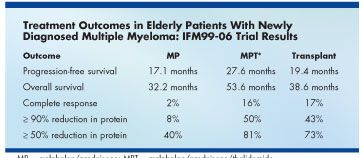Thalidomide Ups Survival in Elderly Myeloma Patients
Elderly patients with newly diagnosed multiple myeloma are likely to survive nearly 2 years longer if thalidomide (Thalomid) is added to the standard melphalan/prednisone (MP) regimen, and they may gain about 10 months longer progression-free survival (PFS),
ASCO Elderly patients with newly diagnosed multiple myeloma are likely to survive nearly 2 years longer if thalidomide (Thalomid) is added to the standard melphalan/prednisone (MP) regimen, and they may gain about 10 months longer progression-free survival (PFS), French researchers reported at the 42nd Annual Meeting of the American Society of Clinical Oncology (abstract 1). Thierry Facon, MD, professor of hematology, University of Lille, France, reported the findings of the trial (IFM99-06) on behalf of the Intergroupe Francophone de Myelome.
"The results of MP plus thalidomide [MPT] were so superior that enrollment in the study was stopped [after enrollment of 447 patients] so that everyone who was receiving MP alone could have thalidomide added to their treatment," Dr. Facon said.
He noted that median survival with MP in multiple myeloma patients age 65 and older is approximately 3 years, "and new treatment regimens are needed."
Patients in the IFM99-06 study (age 65 to 75) were randomized to receive MP (12 courses at 6-week intervals); MPT (the same MP regimen with thalidomide added at the maximum tolerated dose but no more than 400 mg/d); or stem cell marrow transplant (with a MEL100-based regimen). Clodronate was given to all patients.
"Of note," Dr. Facon commented, "while other studies have evaluated thalidomide in elderly myeloma patients, this study was the first and only study to evaluate thalidomide in combination with MP against both MP alone and stem cell transplantation."
Of the 447 patients, 196 were randomized to the MP arm, 125 to the MPT arm, and 126 to the MEL100 transplant arm.
At 12 months, a complete response was achieved in 2% of the MP arm (as expected), and in 16% and 17% of the MPT and MEL100 arms, respectively (see Table). Dr. Facon noted that the differences between the two experimental arms and the MP arm were "highly significant."

At median follow-up of 37 months, overall survival and PFS were both significantly longer with MPT (see Table). "The median progression-free survival time was approximately 28 months in the MPT group, compared to 17 months in the MP group and 19 months in the MEL100 group," he said. This PFS advantage translated into a significant overall survival advantage. Median survival time was 54 months for MPT, compared to 32 months and 39 months for MP and MEL100, respectively.
"Regarding the primary endpoint, overall survival, the superiority of MPT was statistically significant against both MP and MEL100. Statistically significant results were also achieved regarding PFS," Dr. Facon said. "In contrast, no difference was observed regarding MP and MEL100 in terms of response, PFS, and overall survival."
Toxicity
There were significantly fewer early deaths (less than 3 months) and toxic deaths in the MPT arm: early deaths: 3% for MPT vs 8% for MP and 9% for transplant (P = .05); toxic deaths: 0%, 2%, and 5%, respectively (P = .04).
Although MPT toxicity was higher than MP toxicity, Dr. Facon called it "acceptable." Nonhematological toxicities grade 3 or higher were 15.5% for MP, 42% for MPT, and 57% for MEL100. The MPT patients had significantly more grade 3 or higher neutropenia than the MP patients (48% vs 26%, P<.001).
In the thalidomide group, 12% of patients developed grade 3 or higher deep-vein thromboses vs 4% in the MP group and 8% in the MEL100 group (P = .03). About 30% of the patients in the MPT group developed peripheral neuropathy (6% grade 3 or higher), a side effect that was not observed in the other two treatment arms and is commonly associated with thalidomide. "Low-molecular-weight heparin prophylaxis could reduce the thrombosis risk, and lower doses of thalidomide and/or shorter treatment duration could lower the risk of neurotoxicity," Dr. Facon suggested.
He concluded that "MPT could be the reference treatment at the present time for newly diagnosed myeloma patients ineligible for high-dose therapy."
Navigating AE Management for Cellular Therapy Across Hematologic Cancers
A panel of clinical pharmacists discussed strategies for mitigating toxicities across different multiple myeloma, lymphoma, and leukemia populations.